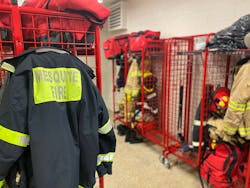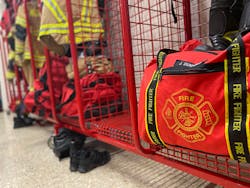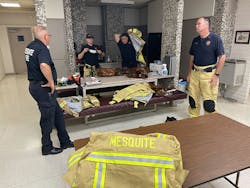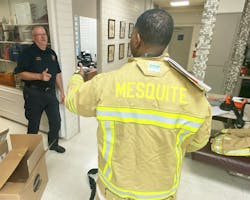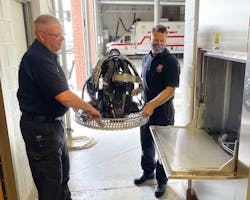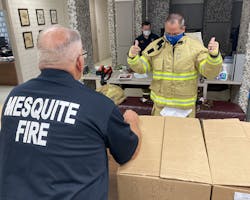Located on the eastern edge of the Dallas-Fort Worth Metroplex, Mesquite, TX, is home to 145,410 citizens and is served by 207 career firefighters. The Mesquite Fire Department operates seven fire stations, seven engines, six full-time ambulances, one peak-time ambulance and two aerials. From medical calls to major vehicle accidents on community streets and five major highways, to structure fires and incidents at industrial plants, the department responded to nearly 19,000 calls for service in 2019.
During the past 17 years, the fire service, in general, and the Mesquite department, in particular, evolved in many ways. One of the most important shifts in the department’s operation took place a little more than four years ago when it began to develop a plan to significantly reduce firefighters’ exposure to carcinogens and other toxins that often are encountered on emergency calls. Since then, fire administration has worked with labor, management and city leaders to achieve this goal.
Beginnings of an initiative
During the past two years, the city of Mesquite invested more than $400,000 in a focused cancer prevention initiative to improve the health and safety of its firefighters, but the journey actually began years ago with the department’s training division. The training division’s captain and lieutenant routinely attended meetings on safety and were educated on the frequent exposures to carcinogens that firefighters face. They understood that we needed to educate the entire department on the risks that are faced on duty, so they brought in a speaker from the Firefighter Cancer Support Network for three days in June 2016. He spoke to each crew, and his message opened the eyes of members not only to the prevalence of cancer among firefighters but also to ways to reduce the risk by preventing exposures. Following the visit that speaker made to the department, there was renewed interest in both making better use of the exposure-reducing equipment that the department already had and in finding ways to make personnel safer by updating procedures and bringing in additional equipment to lessen the risks. It was a turning point for the Mesquite Fire Department and the beginning of the firefighter health and safety program that was put into place at the department.
In 2016, some systems and procedures to reduce exposure to carcinogenic products of combustion already were in place. All seven fire stations were equipped with vehicle exhaust removal systems. Hood exchange at fire scenes had begun, and a procedure was in place to encourage and remind personnel to wash their hoods at least once per month. Gross decontamination (preliminary exposure reduction) practices were being implemented. Disposable wipes were added to all equipment. Two fire stations were equipped with extractors, and soiled gear was sent to those stations for cleaning at the end of the shift following a fire. Personal protective clothing also was sent for advanced professional cleaning, inspection and repair at least twice per year. All of these things helped to reduce firefighters’ exposure to carcinogens, but more was needed.Vehicle exhaust capture and ventilation systems attach to the exhaust pipes to safely collect and vent cancer-causing vehicle exhaust fumes away from the firefighters in the enclosed areas as they leave the station and return from incidents. The first of these systems in the city was installed in 2003 when Mesquite rebuilt Fire Station No. 3. Seeing the advantages of the new technology, the rebuild for Fire Station No. 1 in 2005 also included the new system. An Assistance to Firefighters Grant Program from the federal government then allowed Mesquite to retrofit the remaining five stations and the department’s support facility with the same system. The Firefighter Cancer Support Network speaker’s visit renewed awareness and interest in this equipment departmentwide. As a result, it was learned that, although the equipment was installed in all of Mesquite’s fire station bays since the mid-2000s, it wasn’t used consistently over the years, and some of it needed repair. The repairs to the equipment that required it were made, and crews began to use it more regularly.
Carcinogens on clothing
In 2018, the Mesquite Fire Department developed and proposed a two-part program to decrease exposure to carcinogens that collect on protective clothing while working a fire. The first step was to have a washer/extractor installed in all fire stations. (Extractors had been at two stations.) The city council approved the purchase and installation of five additional extractors in July 2018 at a cost of approximately $110,000. Four stations then were retrofitted to accommodate an extractor, adding water, drainage and power, and the last extractor was installed when Station No. 4 was rebuilt. Now all of our crews have the ability to clean their gear as soon as they return from a fire to the firehouse.
The second part of the program was purchasing additional sets of bunker gear for crews to wear while their soiled gear was being cleanedAs of the summer of 2020, every Mesquite firefighter who is assigned to an operational position is provided with two sets of bunker gear that are sized specifically to him/her. A fire captain oversees the delivery and fitting of each set of bunker gear and also is tasked with providing guidance on its proper use and maintenance.
Incredible advances in bunker gear design and fabric technology occurred in recent years. As a result, as old or damaged gear is replaced in the department, new sets that are purchased offer greatly improved coverage and protection, particularly in the neck, wrist and pant cuff interface areas where particulates tend to collect. Training firefighters on the correct way to don the new gear also is critical, as all of the new closure and interface technology doesn’t make a difference if the gear isn’t worn properly. The personalized attention to detail and updated bunker gear assures that each Mesquite firefighter has gear that both fits properly and provides a greater degree of protection than in years past.
Community support is key
While working to implement the firefighter health and safety program, the department was in the process of designing and building a replacement fire station. New Fire Station No. 4, which opened in June 2020, was constructed on a budget of $5.8 million, with a focus on enhanced safety and health amenities for its crews. The 13,989-square-foot station replaces the 4,500-square-foot former station that was built in 1963. To find the right architect for this project, a lot of questions were asked about each firm’s experience with design considerations that promote firefighter health and safety. The firm that came to the table with the most experience in design to keep cancer-causing agents in the apparatus bay and away from living quarters was selected. Station No. 4 features specially designed airlock passages that help to prevent carcinogens that are in the apparatus bay from entering the living quarters. Showers are located immediately off of the bay for firefighters to use if needed. This is another feature of the station that’s designed to help to keep contaminants outside of the living quarters. Designed by Brown Reynolds Watford Architects and constructed by SEDALCO Construction Services, Fire Station No. 4 is a wonderful example of placing firefighter health as the top priority when building a station.
The comprehensive approach of education, providing a second set of bunker gear for all operations personnel, machine-cleaning PPE following each exposure to products of combustion, and reducing carcinogens in apparatus bays and in station living quarters position the Mesquite Fire Department as a leader in firefighter health and safety in Texas and truly makes a difference for personnel. However, all of these changes wouldn’t be possible without the support of the city’s citizens, the Mesquite Firefighters Association Local 1518, city management and elected officials. They all created an environment and culture that makes the health of firefighters a top priority. In an era of ultratight budgets, it is uplifting to witness the overall support for a multifaceted program that promotes firefighter safety, which demonstrates that the community genuinely cares about its firefighters as professionals and as people.
Continue the effort
I hired on with the Mesquite Fire Department in 1985 and watched the fire service transition from old ways to modern ways. I was caught between not wearing an SCBA on certain fire calls to always wearing one, as the standards evolved. I was in that in-between generation.
I recall seeing a video a few years ago by a Swedish consortium that shows the Skellefteå Model for firefighter health and safety. When I saw it, I believed that it was so outside of my realm of thinking. I asked myself, “How could you do that and still function in a busy fire department environment in the United States?” Today, I realize that it isn’t so far-fetched. In fact, we applied many of the principles in our department. The protection of firefighters is essential. We can’t stand still as research keeps showing that firefighters are at a higher risk of cancer than the public because of dangers of the job. We must continue to improve and invest in the health and safety of our people.
About the Author
Berman Mark Kerby recently retired from the Mesquite, TX, Fire Department after 35 years of service, 17 of which was as fire chief. He attended Eastfield Community College, where he completed his associate degree in 1983. Kerby holds a bachelor of science in business administration and a master’s degree in public affairs from the University of Texas at Dallas. He holds certifications as a Master Fire Fighter and Fire Instructor II from the Texas Commission on Fire Protection. Kerby received certification as a paramedic from UT Southwestern Allied School of Health in 2000. He is a graduate of the Executive Fire Officer Program at the National Fire Academy and is credentialed as a Chief Fire Officer through the Center for Public Safety Excellence. Kerby is a member of the International Association of Fire Chiefs and the Texas Fire Chiefs Association. He has served as president of the Dallas County Fire Chiefs Association and president of the Mesquite Rotary Club.
About the Author
Berman Mark Kerby
Berman Mark Kerby recently retired from the Mesquite, TX, Fire Department after 35 years of service, 17 of which was as fire chief. He attended Eastfield Community College, where he completed his associate degree in 1983. Kerby holds a bachelor of science in business administration and a master’s degree in public affairs from the University of Texas at Dallas. He holds certifications as a Master Fire Fighter and Fire Instructor II from the Texas Commission on Fire Protection. Kerby received certification as a paramedic from UT Southwestern Allied School of Health in 2000. He is a graduate of the Executive Fire Officer Program at the National Fire Academy and is credentialed as a Chief Fire Officer through the Center for Public Safety Excellence. Kerby is a member of the International Association of Fire Chiefs and the Texas Fire Chiefs Association. He has served as president of the Dallas County Fire Chiefs Association and president of the Mesquite Rotary Club.
